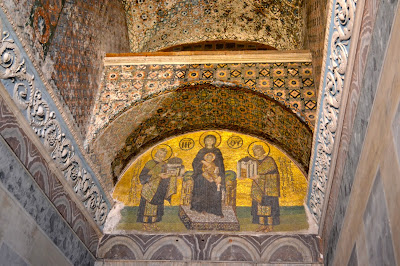Two of the most famous mosques in Istanbul are the Blue Mosque and Hagia Sophia (now a museum). They are both a short walk from the Topkapi Palace with a tree lined square in between the two buildings. The Blue Mosque takes its name from the many blue Iznik tile work (named after the town in Turkey where they were made) on the interior of the church. It is one of the most famous religious buildings in the world and was built in the early 1600's. The Blue Mosque is open for visitors in between prayer times. Since prayer is five times a day, it is wise to check the schedule of prayer times before scheduling a visit. Women's heads have to be covered and everyone takes off their shoes. On the day we visited, tourists from all over the world (very few Americans, if any, at this time of year) lined up to see this incredible structure.
 |
| Square in between the Blue Mosque and Haghia Sophia |
The courtyard covers the same area as the prayer hall (which is huge) which balances the whole building.
 |
| Courtyard of Blue Mosque |
 |
| looking up toward the dome |
Over 250 windows allow light to flood into the mosque.
 |
| Five of the six minarets of Blue Mosque |
 In order to visit the mosque, women have to cover their heads. I'm not sure I'd "fit the bill" here.
In order to visit the mosque, women have to cover their heads. I'm not sure I'd "fit the bill" here.
Haghia Sophia is called the "church of holy wisdom" and is one of the greatest surviving examples of Byzantine architecture. It is more than 1,400 years old and is said to have changed the history of architecture. It was originally constructed as a church. In 1453, Constantinople was conquered by the Ottoman Turks under Sultan Mehmed II who ordered it converted to a mosque. Christian sacrificial vessels and other relics were removed and the mosaics depicting Jesus, Mary, Christian saints and angels were also removed or plastered over. It remained a mosque until 1931 when it was closed for four years. It was reopened in 1935 as a museum by the Republic of Turkey.
 |
| Painted ceilings of the gallery in Haghia Sophia |
This mosaic is from the 13th century and is in the Upper Gallery and it shows Mary with John the Baptist and Jesus.
 This mosaic is seen as you leave the church. It shows Mary seated on a throne holding Jesus and two great emperors of the city. Constantine on her left presents her with the city of Constiatntinople and Justinian offers her Haghia Sophia.
This mosaic is seen as you leave the church. It shows Mary seated on a throne holding Jesus and two great emperors of the city. Constantine on her left presents her with the city of Constiatntinople and Justinian offers her Haghia Sophia.  |
| View to the outside from the upper gallery in Haghia Sophia. |
What an incredible day of discovering the Old City of Istanbul!







No comments:
Post a Comment